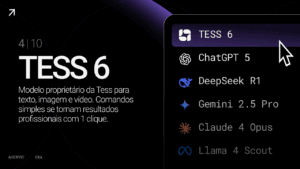Introducing Agent Mode, the most revolutionary feature of the Tess AI platform. An artificial intelligence system that transcends the limitations of traditional assistants, delivering true autonomy in executing complex tasks. Available today for all Tess platform users.
What is Agent Mode?
Agent Mode represents a fundamental evolution from traditional AI assistants – moving from tools that simply respond to systems that act autonomously in the digital world. It’s an AI system that possesses true agency – meaning the ability to:
- Make decisions based on objectives
- Deploy tools and resources as needed
- Iterate and adapt strategies as required
- Operate autonomously within defined parameters
An Explanatory Analogy
Traditional Assistant = Consultant who gives advice
- You ask questions, it responds
- You need to execute the suggestions yourself
Agent Mode = Autonomous specialist employee
- You delegate a task
- It plans, executes, and delivers results
- You guide and review the final output
Architecture and Functionality
Hierarchical Multi-Agent System
In Tess, Agent Mode operates through a sophisticated multi-agent architecture where a main agent coordinates various specialized child agents. Each child agent is optimized for specific tasks—such as DOCX document creation, web development in HTML/CSS/JavaScript, data analysis, and much more.
Integrated Tools
The system has native access to dozens of specialized tools that perform various tasks including:
- Reading content from pages and documents
- Creating files
- Advanced file editing
- Executing Python code
- Reading images
- Processing spreadsheets
- Analyzing video content
- Performing intelligent searches
- Interacting with web page elements, such as filling out forms and clicking buttons
- Extracting data from browsers
- Taking automated screenshots
- Generating and editing images
- Generating and editing videos
- Generating and editing narration files
- Generating music
- Generating videos with Avatars
- And much more
Virtualized Work Environment
Each Agent Mode session creates an isolated computational environment where:
- Agents work in coordination
- All files are organized in a transparent folder system
- Users can monitor progress in real-time
- Visual representation of actions being executed is provided
Technical Performance
GAIA Benchmark
Tess’s Agent Mode achieved superior scores compared to Manus and OpenAI across all three complexity levels of the GAIA Benchmark – the most rigorous evaluation system for next-generation models.
GAIA Results:
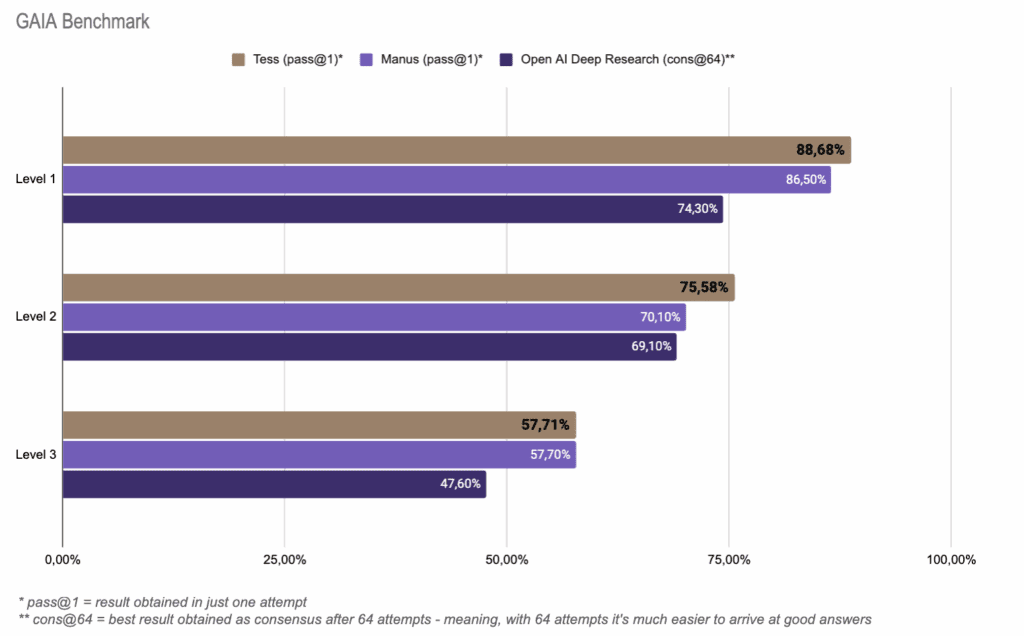
GAIA Levels:
- Level 1 questions generally require no tools, or at most one tool but no more than 5 steps.
- Level 2 question generally involve more steps, roughly between 5 and 10 and combining different tools is needed.
- Level 3 are questions for a near perfect general assistant, requiring to take arbitrarily long sequences of actions, use any number of tools, and access to the world in general.
Level 1 Example
- Question: You are given this Excel file as a map. You start on the START cell and move toward the END cell. You are allowed to move two cells per turn, and you may move up, down, left, or right. You may not move fewer than two cells, and you may not move backward. You must avoid moving onto any blue cells. On the eleventh turn, what is the 6-digit hex code (without prefix) of the color of the cell where you land after moving?
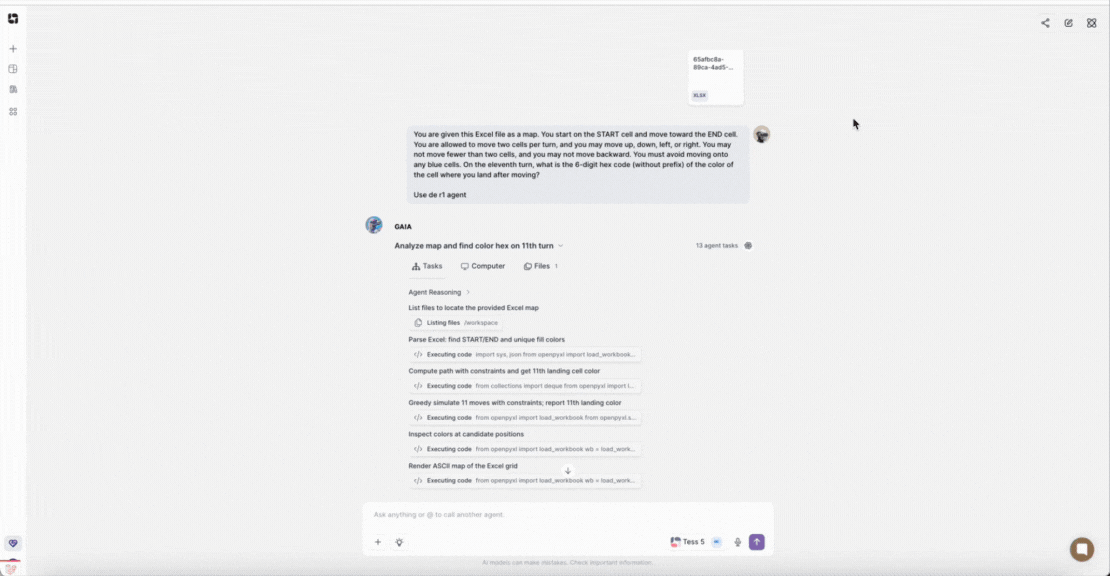
Level 2 Example
- Question: Take the gender split from the 2011 Bulgarian census about those who have completed tertiary education. Subtract the smaller number from the larger number, then return the difference in thousands of women. So if there were 30.1 thousand more men, you’d give “30.1”
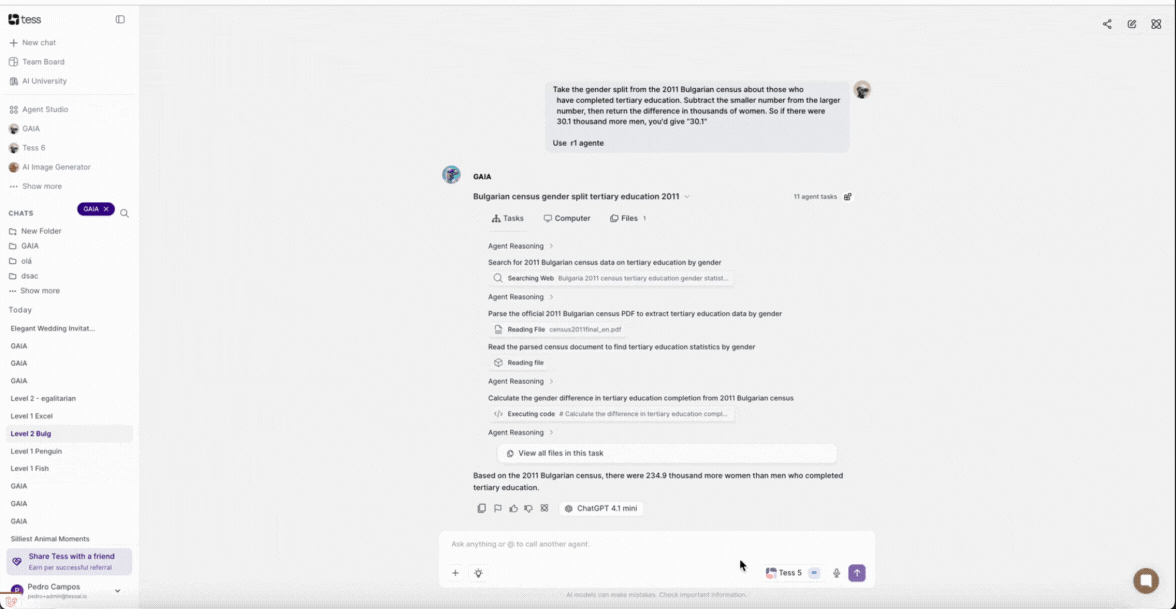
Level 3 Example
- Question: In July 2, 1959 United States standards for grades of processed fruits, vegetables and certain other products listed as dehydrated, consider the items in the “dried and dehydrated section”specifically marked as dehydrated along with any items in the Frozen/Chilled section that contain the whole name of the item, but not if they’re marked Chilled. As of August 2023, what is the percentage of(to the nearest percent) of those standards that have been superseded by a new version since the date given in the 1959 standards?
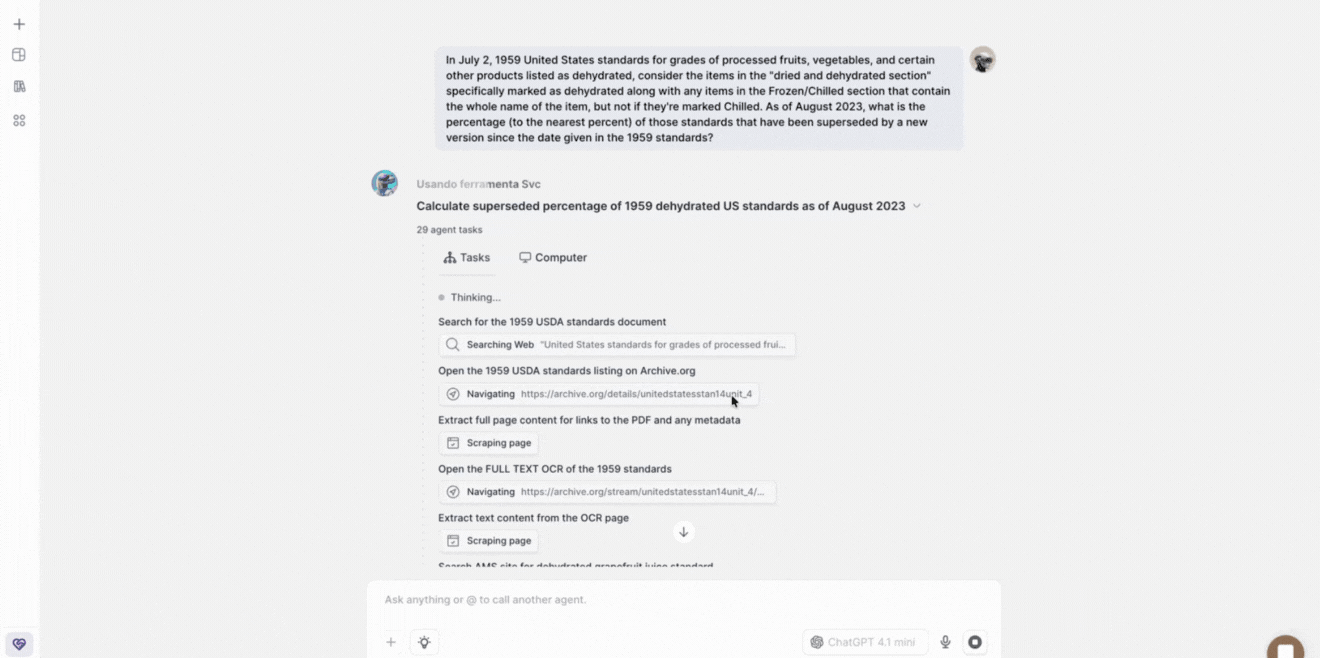
Competitive Advantage
While competitors like Manus and OpenAI limit themselves to their own ecosystems and models, Tess’s Agent Mode:
- Utilizes over 200 AI models simultaneously
- Automatically orchestrates the best capabilities of each model
- Dynamically selects the ideal specialist for each subtask
- Combines different architectures for superior results
Advanced Use Cases
Browser Use (Autonomous Web Navigation)
The system can navigate websites, interact with web elements, extract information, and execute complex actions completely autonomously.
Multimodal Document Creation
- Automatic presentation generation (PPTX)
- Complete website development (HTML/CSS/JS)
- Professional document creation (DOCX/PDF)
- Spreadsheet analysis and processing (CSV/Excel)
Deep Research and Analysis
- Multi-source web investigations
- Competitive market analysis
- Detailed executive reports
- Complex information synthesis
Development and Programming
- Complete web application creation
- Code debugging and optimization
- API and service integration
- Automated deployment
How It Works
Execution Flow
- Task Reception: User defines the desired objective
- Strategic Planning: Master agent analyzes and breaks down the task
- Intelligent Delegation: Specialized agents are deployed
- Coordinated Execution: Parallel and sequential work as needed
- Continuous Monitoring: Real-time adjustments based on results
- Final Delivery: Complete result with transparent documentation
Monitoring Interface
Users have complete access to the process through:
- Real-time visualization of actions being executed
- Transparent file system showing all created documents
- Detailed log of each tool utilized
- Visual representation of the computational environment
Technological Differentiator
Multi-Model Orchestration
The key differentiator of Agent Mode lies in its ability to intelligently orchestrate hundreds of specialized models. While other solutions are limited to a restricted set of proprietary models, Tess:
- Accesses Claude, GPT, Gemini, Qwen and dozens of other models
- Automatically combines the specific strengths of each architecture
- Optimizes selection based on task nature
- Adapts strategies according to intermediate results
Reflection and Adaptation
Using advanced reinforcement learning techniques, the system:
- Continuously monitors result quality
- Adjusts strategies in real-time
- Learns from each interaction
- Progressively improves its effectiveness
Availability and Access
Agent Mode is available through an Invitation system. Interested in receiving early access to this feature? Sign up for the Waitlist.
The Future of Brazilian AI
This launch marks a historic moment: a Brazilian company leading global innovation in artificial intelligence. Agent Mode isn’t just a feature – it’s the materialization of a vision where Brazil takes center stage in the most important transformations of the 21st century.
Each optimized algorithm, each developed integration, each line of code represents our ability to compete – and win – on the global technology stage.
Agent Mode transforms the AI work experience from a tool that responds to a specialist that delivers. It’s the future arriving today, and it speaks Portuguese.
To experience Agent Mode early, sign up for our Waitlist.
One command. Infinite possibilities.
Welcome to Tess’s Agent Mode.

